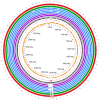Characterization of a stable, metronidazole-resistant Clostridium difficile clinical isolate
- PMID: 23349739
- PMCID: PMC3547915
- DOI: 10.1371/journal.pone.0053757
Characterization of a stable, metronidazole-resistant Clostridium difficile clinical isolate
Abstract
Background: Clostridium difficile are gram-positive, spore forming anaerobic bacteria that are the leading cause of healthcare-associated diarrhea, usually associated with antibiotic usage. Metronidazole is currently the first-line treatment for mild to moderate C. difficile diarrhea however recurrence occurs at rates of 15-35%. There are few reports of C. difficile metronidazole resistance in the literature, and when observed, the phenotype has been transient and lost after storage or exposure of the bacteria to freeze/thaw cycles. Owing to the unstable nature of the resistance phenotype in the laboratory, clinical significance and understanding of the resistance mechanisms is lacking.
Methodology/principal findings: Genotypic and phenotypic characterization was performed on a metronidazole resistant clinical isolate of C. difficile. Whole-genome sequencing was used to identify potential genetic contributions to the phenotypic variation observed with molecular and bacteriological techniques. Phenotypic observations of the metronidazole resistant strain revealed aberrant growth in broth and elongated cell morphology relative to a metronidazole-susceptible, wild type NAP1 strain. Comparative genomic analysis revealed single nucleotide polymorphism (SNP) level variation within genes affecting core metabolic pathways such as electron transport, iron utilization and energy production.
Conclusions/significance: This is the first characterization of stable, metronidazole resistance in a C. difficile isolate. The study provides an in-depth genomic and phenotypic analysis of this strain and provides a foundation for future studies to elucidate mechanisms conferring metronidazole resistance in C. difficile that have not been previously described.
Conflict of interest statement
Figures





References
-
- Kyne L, Hamel MB, Polavaram R, Kelly CP (2002) Health care costs and mortality associated with nosocomial diarrhea due to Clostridium difficile Clinical Infectious Diseases 34 (3): 346–353 20 March 2012. - PubMed
-
- Johnson S, Samore MH, Farrow KA, Killgore GE, Tenover FC, et al. (1999) Epidemics of diarrhea caused by a clindamycin-resistant strain of Clostridium difficile in four hospitals. N Engl J Med 341 (22) 1645–1651 20 March 2012. - PubMed
-
- Gravel D, Miller M, Simor A, Taylor G, Gardam M, et al. (2009) Health care-associated Clostridium difficile infection in adults admitted to acute care hospitals in Canada: A Canadian nosocomial infection surveillance program study. Clinical Infectious Diseases 48 (5) 568–576 8 March 2012. - PubMed
-
- McDonald LC, Killgore GE, Thompson A, Owens RC Jr, Kazakova SV, et al. (2005) An epidemic, toxin gene-variant strain of Clostridium difficile . N Engl J Med 353 (23) 2433–2441 10.1056/NEJMoa051590. - PubMed
Publication types
MeSH terms
Substances
LinkOut - more resources
Full Text Sources
Other Literature Sources
Medical
Molecular Biology Databases

